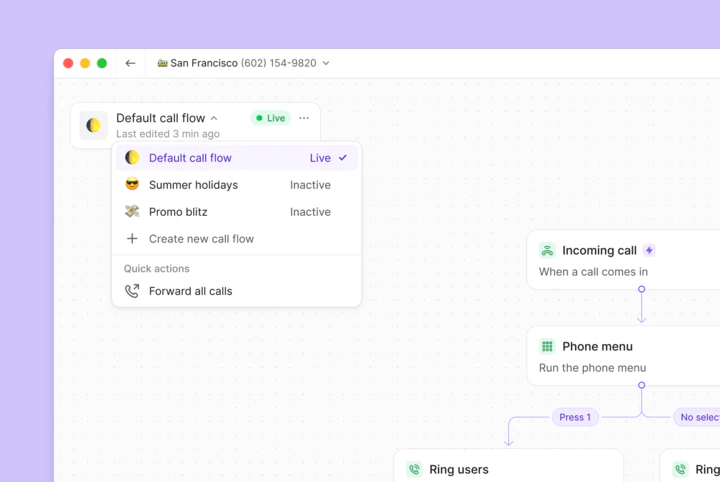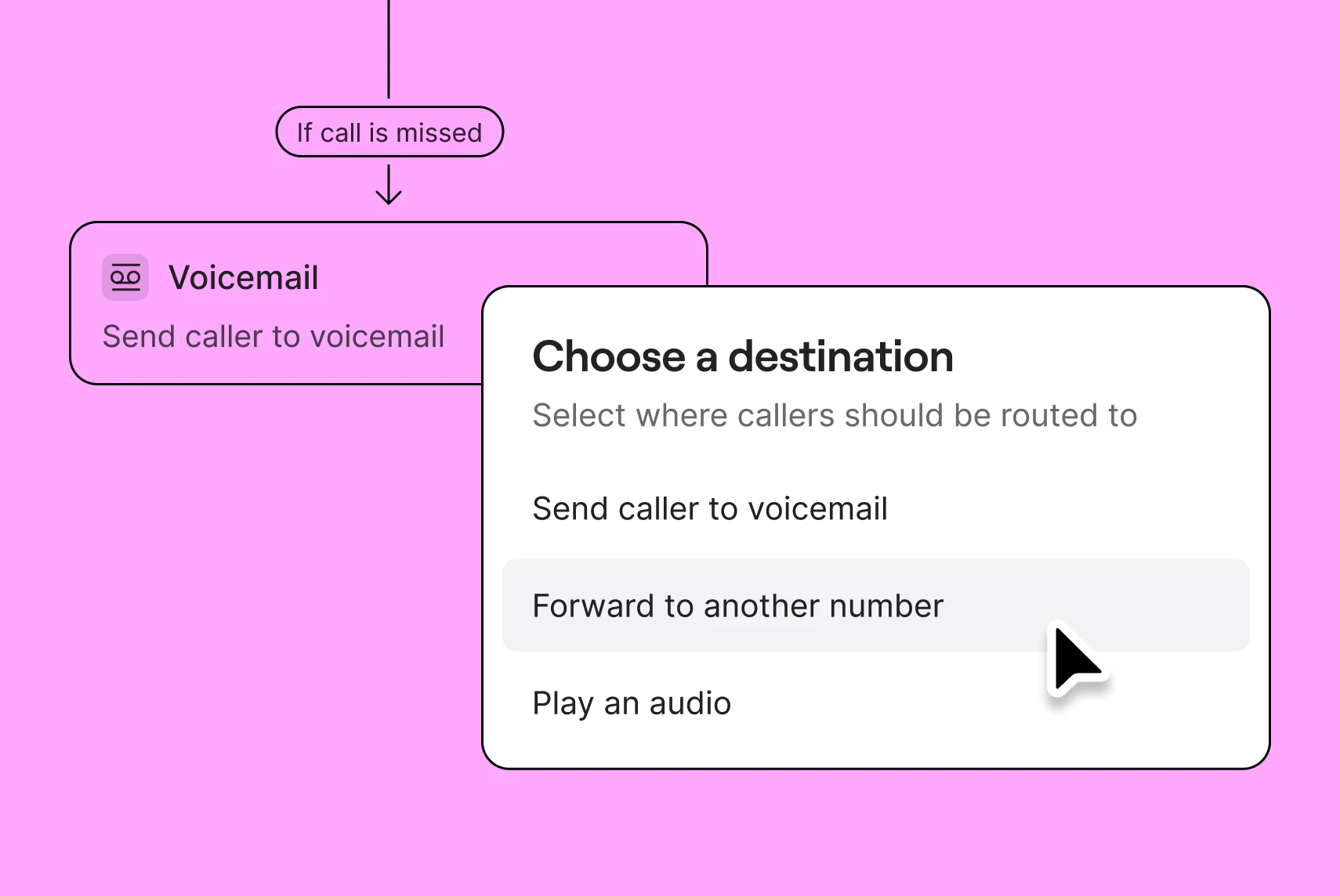Connect callers to your team automatically with Quo’s call routing features. Customize your ring order, business hours, and phone menus with our visual drag-and-drop call flow builder. Plus, answer every incoming call with our AI agent, Sona.








Call routing is a phone system feature that directs incoming calls to teams based on preset rules and criteria. You can route calls to your team based on their availability, your caller’s preferences, the time of day, and similar conditions.
Call routing is useful for small and growing businesses because it helps reduce missed calls and increase your team’s efficiency. Incoming calls reach team members based on their availability. With phone menus, callers can connect directly with specific team members. It can improve their customer experience because they don’t have to wait on hold or go through multiple call transfers.
Call routing software isn’t just meant for large call centers or contact center teams. While enterprises previously had access to complex call routing features, they’re now available in modern business phones. You don’t need any technical expertise either. Business phone systems like Quo provide visual drag-and-drop call flow builders to set up custom call routing in minutes.
There are six methods of call routing available on Quo.

Ring available teammates on a shared phone number simultaneously.
Ring teammates in predetermined batches using sequential ring. If one batch isn’t available, the call proceeds to the next batch. It’s also known as list-based routing.
Ring teammates with equal call distribution so that everyone gets a chance to speak to your customers. Set up round-robin call routing by rotating individuals in your ring groups every week.
Ring available teammates based on their shift times. Team members can set up their shifts in Quo with work schedules.
Customize your call routing with time-of-day routing. Offer different call routing options during business hours vs after hours.
Answer incoming calls 24/7 with our AI voice agent Sona. Provide custom instructions to Sona to transfer calls to your team.
That’s it! You’re ready to route calls based on a time schedule.



Fast-growing small business teams can quickly set up and modify their call flows with Quo. Get access to powerful call flow features usually reserved for large call centers.
Drag and drop Quo call flow steps in our visual call flow builder. No technical experience required.


Toggle between your default and custom call flows based on your team’s needs. Set up call flows for weekend hours, holiday hours, or if your team is dealing with an emergency.
Always have a backup option available for your callers so you don’t miss out on potential customers. Set up custom voicemails, SMS auto-replies, or call forwarding to a backup number or Sona.

Phone menus
Provide self-service options to your customers with an auto-attendant or IVR
Warm call transfers
Hand off callers to your colleagues with the right amount of context
Ring order
Control how calls reach your team with custom ring groups
Temporary call flows
Switch between default and custom call flows depending on your business needs
Play audio
Play a pre-recorded audio message to keep customers in the loop
Group calling
Bring your stakeholders together in the same conversation
See how small business teams grow faster with our intelligent call routing system.
Call routing helps your team tackle your inbound call volume. With shared numbers, incoming calls reach team members based on your ring preferences.
If your team is busy or unavailable, you can route calls to backup options like an AI answering service. AI agents like Sona are more interactive and engaging for customers. They’re more likely to leave a message with an AI voice agent than voicemail.
Call routing saves time for your customers. They can connect directly with specific team members or leave a message with your answering service. No more call transfers or call queueing with long wait times.
Give self-service routing options to your customers with a phone menu. If someone has a basic question about your business hours, they can speak to an AI agent. If they want to get a quote from your team, they can speak to one of your reps. When you provide multiple options, customers can choose the one that works best for them.
Take hours off your team’s plate. Help them focus on the calls that need their attention.
Effective call routing ensures that calls are directed to the right person. Your team doesn’t have to manually transfer callers. You can also reduce their incoming call volume by routing basic questions to an AI receptionist. You can also use Sona as a callback service. Prioritize which customers need your immediate attention and call them back.
Save time on routine tasks and provide a better experience to your customers with Quo.
%20(1).jpg)
Quo allows you to get as many numbers as you need for your business. You can assign numbers to individual employees, teams, or specific locations. Get US or Canadian numbers with local area codes that inspire trust. Or get a North American toll-free number to serve clients across the continent. Plus, you can port in existing numbers without worrying about service interruptions.
Every user in your Quo workspace gets a dedicated number. You can also set up shared numbers for individual departments or across the company. If you need more numbers, additional ones cost $5 per number per month.
With Quo, you don’t have to worry about overage fees or maxing out your call minutes. You can make unlimited phone calls to anyone in the US or Canada. If you have contacts in other countries, you’ll only pay a fraction of what you’d spend with a traditional carrier.
Continue your conversations over text with Quo’s business SMS and MMS messaging features. Send unlimited texts to US and Canadian numbers. You can use both local and toll-free numbers to message customers. Schedule messages to reach customers in their time zones. Set up responses to FAQs or common message templates as snippets in your workspace.
Use your existing devices to access Quo’s cloud-based platform. You can reach contacts from almost anywhere, using your computer, tablet, or smartphone. All you need is an internet connection or mobile data to reach your contacts. Our desktop and mobile apps are available for Mac, Windows, iOS, and Android. You can also use our web app in your browser to make calls and send texts.
Help your team stay aligned on your business phone communication. With shared numbers, multiple teammates can send and receive messages at the same time. That way, your team can split responsibility for incoming calls and messages. Shared inboxes make it easy to catch up on customer conversations as well.
Not sure how to answer a specific message? You can collaborate in real time using internal threads. Tag a team member right next to a customer’s message and ask for their input. Internal threads are visible only to your team.
Connect Quo with other key tools in your tech stack. Share call and text information where it matters to your team. You can log all phone communications by integrating Quo with your CRM. Quo has CRM integrations with HubSpot, Jobber, and Salesforce. You can also connect Quo with your Slack and email accounts. Plus, you can build custom integrations using Zapier and Make. If you have technical expertise, you can build your own integration with the Quo API.
Get more work done with Quo’s automation features. Answer calls stress-free with our automatic call recording and call summary features. Say goodbye to taking notes on calls. Every call summary also comes with a timestamped call transcription and action items. Keep track of all your customer conversations in one place.
Automate common text messaging workflows. Set up SMS auto-replies to keep customers in the loop. You can set call routing rules to send SMS messages if you miss a call. Create multi-step Zapier and Make texting workflows for your business needs. For example, you can send appointment confirmations, reminders, and follow-up requests automatically.
Help your team get better with each call and text. Quo’s monitoring and analytics tools help you identify areas of improvement.
See how your team is doing in real time with call views. Sort through your calls with filters for call tags or contact properties. View high-level trends across your team with our analytics dashboard. Get a weekly, monthly, quarterly, and annual view of your team’s performance.
Find out how much you’re investing in your business phone solution upfront on our pricing page.
Can’t find the answer here? Check out our Resource Center.
Call routing works by directing calls through a series of preset rules. These rules determine which member of your team receives an incoming call.
Here are a few different ways business phone systems route calls for you:
Call routing is a business phone feature that directs incoming calls to team members based on preset criteria. This can include business needs, rep availability, and customer preferences.
Call distribution, on the other hand, is a call routing feature that automatically prioritizes which team members will receive an incoming call. Automatic call distribution, or ACD, is a common feature in call center software. With ACD, each agent’s performance is evaluated by metrics like first call resolution and call handling time.
Small business teams don’t need ACD in their business phone because they won’t be evaluating team members by those metrics.
Skills-based routing connects callers with team members who have the skillsets to address customer needs.
For example, if a customer calls to return a product to a business, skills-based routing can connect them to the right rep.
You don’t need contact center software to implement skills-based routing in your business. With a phone menu, you can give customers the option to connect with team members based on their area of expertise.
Quo’s Starter plan offers business hours, basic call forwarding, and shared number routing. The Business plan offers phone menus, custom ring groups, and advanced call forwarding. All Quo plans give you access to the call flow builder. You can also use Sona on any Quo plan.
Here are five best practices you can use to set up a call routing strategy that works for your team:
Yes, Quo’s call management system allows users to make call transfers to any US or Canadian phone number.
Join thousands of businesses already using Quo to communicate better with their customers.